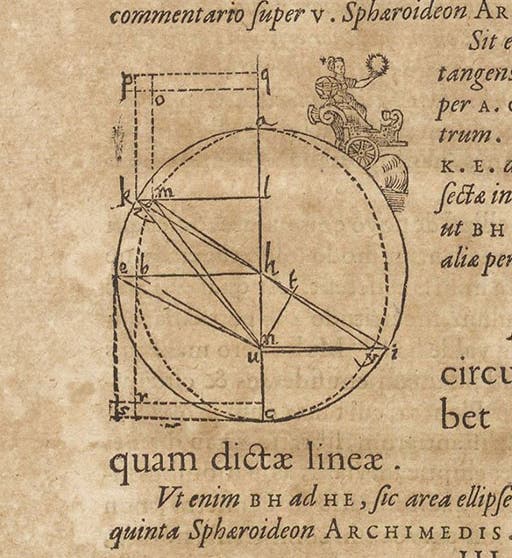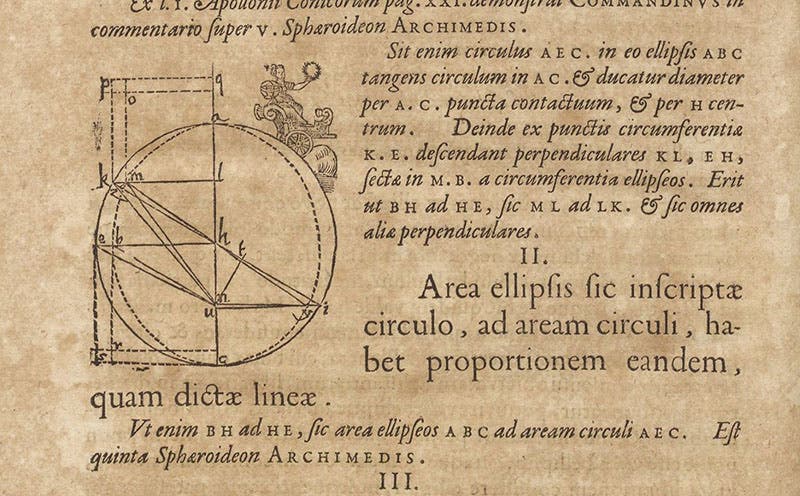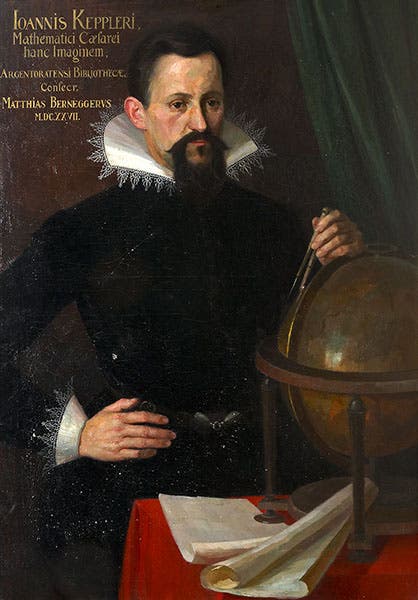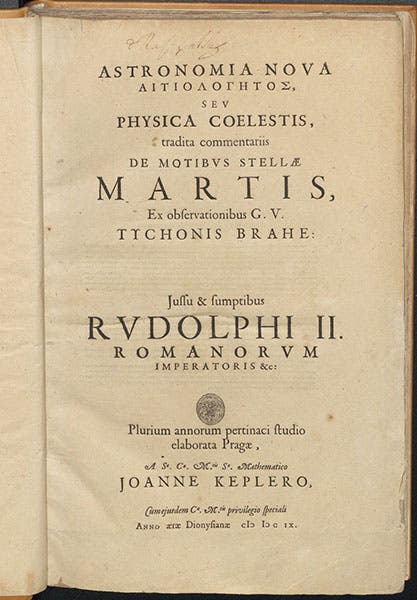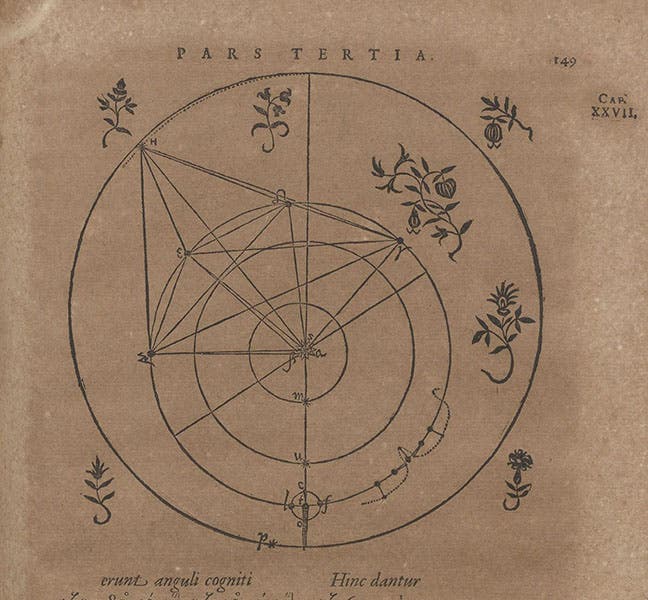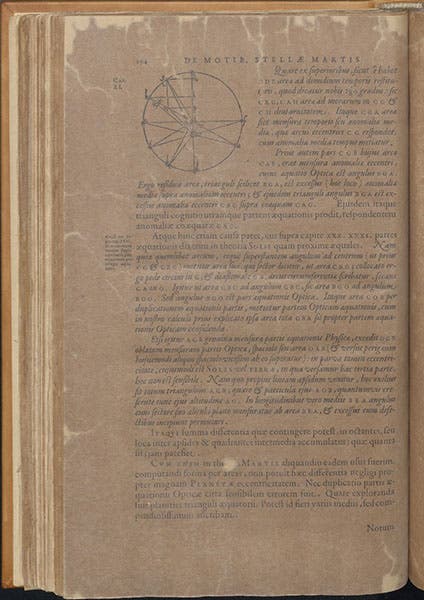Scientist of the Day - Johannes Kepler
Johannes Kepler, a German astronomer, was born Dec. 27, 1571. Kepler was the most original and accomplished astronomer of the entire 17th century, an era that includes Isaac Newton, Christiaan Huygens, Johannes Hevelius, and quite a few other gifted astronomers. We have written three posts about Kepler, in which we discussed his first book, the Cosmographic Mysteries; his book on the new star of 1604; and his use of emblematic imagery in the frontispiece to hIs Rudolphine Tables (1627). But we have not yet discussed what is certainly his most important work, the Astronomia nova seu Physica coelestis, in which we can find his first two laws of planetary motion, one of which reveals that that planets move in elliptical orbits, rather than the circular orbits that astronomers had presumed were the case since ancient times.
Kepler had been set to work on determining a better orbit for Mars by his then boss, Tycho Brahe, Imperial Mathematician for Rudolph II, Holy Roman Emperor. Orbits accounting for Mars, using conventional epicycles, deferents, and equant points, had been devised by the ancient astronomer Ptolemy, by Nicholas Copernicus, and by Brahe, but Mars was the most ill-behaved of all the planets, and sometimes predicted positions differed from observed ones by as much as two degrees, which was a huge discrepancy. Brahe wanted Kepler to come up with a better model for Mars. He naturally assumed, as did Kepler, that an improved orbit would be based on circles. One of the diagrams in the Astronomica nova depicts circle-based orbits for Mars according to the three major astronomical systems (third image)
Kepler began his “war on Mars,” as he called it, in 1600, and when Tycho died in 1601, and Kepler succeeded him as Imperial Mathematician, he kept right on battling. One of the engaging features of a Keplerian book is that it is written as a diary; Kepler did not go back and remove wrong turns and mistaken hypotheses, so the Astronomia nova is a lengthy account of all his varied attempts at coming up with an orbit that was in better accord with Tycho’s observations, and we find no mention of ellipses until chapter 59, near the end of the book. Kepler devised one orbital mechanism, called his “vicarious hypothesis,” that was excellent, yielding predictions that were off, at their worst, by only 8 minutes of arc, which was about 15 times better than any other astronomical model. But in a famous act of empirical bravado, Kepler rejected the orbit as unsatisfactory, for he knew that Tycho’s observations were accurate to within 4 minutes of arc, so the vicarious hypothesis could not be correct.
It was at this point that Kepler tried an elliptical orbit for Mars, just as an approximation, and was stunned when the errors were reduced to zero (first image). He was unable to find a way to build an elliptical orbit from circular motion, which is what he wanted to do, and he finally concluded that circles are just not a part of the equation – planets (at least the planet Mars) move in elliptical orbits, with the Sun at one focus of the ellipse. This is now known as Kepler’s first law. The Astronomia nova also contains a statement of Kepler’s second law (which he found first), that planets in their orbit sweep out equal areas in equal time, a result of their moving faster when they are closer to the Sun.
The real novelty of the Astronomia nova is hinted at by the rest of the title: This was a new astronomy based on celestial physics. Before Kepler, physics was a terrestrial science; there was no celestial physics, no searching for causes in planetary movements. Kepler invented celestial physics, declaring that planets cannot be affected by empty points (such as an equant or a “mean sun”) and can only respond to physical bodies. He made the real Sun the focal point of every planetary orbit, and even suggested that the Sun moves the planets via a magnetic force that sweeps the planets through their orbits as the Sun rotates. This was as much of an astronomical revolution as that inaugurated by Copernicus 66 years earlier.
It would take some time before European astronomers realized what Kepler had accomplished, and came to accept elliptical orbits and celestial physics. Kepler’s third law – the period law - was only discovered and announced 10 years later, in his Harmonice mundi, about which we will write another post someday.
The Linda Hall Library has one of the finest Kepler collections in the United States – some 26 first editions by my last count, and I know we have added at least one since then. Most of these are in excellent condition, but our copy of the Astronomia nova, for many years, was not. In the first third of the 17th century, many German publishers unknowingly printed books on paper that was acidic, with the result that, over the centuries, the paper browned and turned brittle. Many copies of William Harvey’s De motu cordis (1628), printed in Germany, were the victims of acidic paper, and so were some copies of Kepler’s Astronomia nova. Our copy, which came to us from the American Academy of Arts and Science in Boston, was one of those, with some very browned signatures and with some of the pages falling apart. Our fifth image shows a diagram from one of the heavily browned pages. In the 1980s, we sent the book out to conservators, who disassembled it, washed and deacidified each leaf, and rebound the book. The few leaves that were falling apart were backed with Japanese tissue to hold them together (sixth image). The book is now environmentally stable and has a long shelf-life ahead of it. It is sobering to look at it every now and then, as a reminder of how lucky we are that most early printed books were printed on excellent quality paper and are still in fine condition. What a tragedy it would be if the legacy of the early printed book was a mountain of paper fragments and dust. It could have turned out that way.
The portrait of Kepler we include here was painted by Matthias Bernegger in 1627 and is in the Kepler Museum in Weil-der-Stadt, where Kepler was born. You can see another portrait in our second post on Kepler.
William B. Ashworth, Jr., Consultant for the History of Science, Linda Hall Library and Associate Professor emeritus, Department of History, University of Missouri-Kansas City. Comments or corrections are welcome; please direct to ashworthw@umkc.edu.

